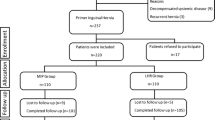Abstract
Male veterans with unilateral primary inguinal hernia, classified intraoperatively as Gilbert Type III or IV, were randomized to subaponeurotic (Lichtenstein, n=126) or preperitoneal (Read-Rives, n=121) repair under general or spinal anesthesia. The two groups of patients were comparable in age, body weight index, comorbidities, and size and type of hernia. Of the 247 patients enrolled, 224 were followed for at least 2 years (median 82 months, range 24–110 months), 16 were lost to follow-up, and seven died from causes unrelated to the surgery. The average operative time of the Read-Rives repair was 9 min longer than that of the Lichtenstein repair. There were no wound infections, and the frequencies of other short- and long-term complications were low and similar in the two groups. Six patients developed hernia recurrence, five in the Lichtenstein group (4.3%), and one in the Read-Rives group (<1%), (P=0.21). Both anterior repairs are associated with low postoperative morbidity and recurrence rates. The Lichtenstein repair is technically easier and less time consuming. There is no statistically significant difference in the recurrence rate between the two repairs.
Similar content being viewed by others
References
Read RC (1984) The development of inguinal herniorrhaphy. Surg Clin North Am 64:185–196
Read RC (1997) Annandale’s role in the development of preperitoneal groin herniorrhaphy. Hernia 1:111–115
Read RC (1999) Francis C Usher: the herniologist of the twentieth century. Hernia 3:57–61
Read RC (2003) Recent advances in the repair of groin herniation. Curr Probl Surg 40:1–80.
Stoppa RE (1995) Errors, difficulties, and complications in hernia repairs using the GPRVS. Probl Gen Surg 12:139–148
Usher FC, Ochsner J, Tuttle LL Jr (1958) Use of Marlex mesh in the repair of incisional hernias. Am Surg 24:969–974
Lichtenstein IG, Shulman AG (1986) Ambulatory (outpatient) hernia surgery including a new concept: introducing tension-free repair. Int Surg 71:1–4
Amid PK, Shulman AG, Lichtenstein IL (1994) A critical evaluation of the Lichtenstein tension-free hernioplasty. Int Surg 79:76–79
Amid PK, Shulman AG, Lichtenstein, IL (1993) Critical scrutiny of the open “tension-free” hernioplasty. Am J Surg 165:369–371
Friis E, Lindahl F (1996) The tension-free hernioplasty in a randomized trial. Am J Surg 172:315–319
McGillicuddy F (1998) Prospective randomized comparison of the Shouldice and Lichtenstein hernia repair procedures. Arch Surg 133:974–978
The EU Hernia Trialists Collaboration (2000) Mesh compared with non-mesh methods of open groin hernia repair: systematic review of randomized controlled trials. Br J Surg 87:854–859
The EU Hernia Trialists Collaboration (2002) Repair of groin hernia with synthetic mesh: meta-analysis of randomized controlled trials. Ann Surg 235:322–332
Vrijland W, vanden Tol M, Luijendij RW, Hop WC, Busschbach JJ, deLange DC, van Geldere D, Rottier AB, Vegt PA, Ijzermans JN, Jeekel J (2002) Randomized clinical trial of non-mesh versus mesh repair of primary inguinal hernia. Br J Surg 89:293–297
Shulman AG, Amid PK, Lichtenstein IL (1995) Mesh between the oblique muscles is simple and effective in open hernioplasty. Am Surg 61:326–327
Bringman S, Ramel S, Heikkinen TJ, Englund T, Westman B, Anderberg B (2003) Tension-free inguinal hernia repair: TEP versus mesh-plug versus Lichtenstein: a prospective randomized controlled trial. Ann Surg 237:142–147
MRC Laparoscopic Groin Hernia Trial Group (1999) Laparoscopic versus open repair of groin hernia: a randomized comparison. Lancet 354:185–190
Wright D, Paterson C, Scott N, Hair A, O’Dwyer P (2002) Five-year follow-up of patients undergoing laparoscopic or open groin hernia repair: a randomized controlled trial. Ann Surg 235:333–337
Gilbert AI (1989) An anatomic and functional classification for the diagnosis and treatment of inguinal hernia. Am J Surg 157:331–333
Lichtenstein IL, Shulman AG, Amid PK, Montllor MM (1989) The tension free hernioplasty. Am J Surg 157:188–193
Read RC, Barone GW, Hauer-Jensen M (1993) Properitoneal prosthetic placement through the groin. Surg Clin North Am 73:545–555
Crawford D, Phillips E (2002) Laparoscopic totally extraperitoneal herniorrhaphy. In: Fitzgibbons RJ, Greenberg AG (eds) Nyhus and Condon’s Hernia, 5th edition. JB Lippincott, Philadelphia, pp 239–253
Mikkelsen T, Bay-Nielsen M, Kehlet H (2002) Risk of femoral hernia after inguinal herniorrhaphy. Br J Surg 89:486–488
Amid PK (2002) How to avoid recurrence in Lichtenstein tension-free hernioplasty. Am J Surg 184:259–260
Amid PK, Lichtenstein IL (1998) Long-term results and presentation of data on the Lichtenstein open tension-free hernioplasty. Hernia 2:89–94
Bay-Nielsen M, Nordin P, Nilsson E, Kehlet H (2001) Operative findings in recurrent hernia after Lichtenstein procedure. Am J Surg 182:134–136
Lowham AS, Filipi CJ, Fitzgibbons RJ, Stoppa R, Wantz GE, Felix EL, Crafton WB (1997) Mechanisms of hernia recurrence after preperitoneal mesh repair: traditional and laparoscopic Ann Surg 225:442–431
Kux M (2002) Anatomy of the groin: a view from the surgeon. In: Fitzgibbons RJ, Greenberg AG (eds) Nyhus and Condon’s Hernia, 5th edition. JB Lippincott, Philadelphia, pp 45–53
Author information
Authors and Affiliations
Corresponding author
Rights and permissions
About this article
Cite this article
Muldoon, R.L., Marchant, K., Johnson, D.D. et al. Lichtenstein vs anterior preperitoneal prosthetic mesh placement in open inguinal hernia repair: A prospective, randomized trial. Hernia 8, 98–103 (2004). https://doi.org/10.1007/s10029-003-0174-5
Received:
Accepted:
Published:
Issue Date:
DOI: https://doi.org/10.1007/s10029-003-0174-5




